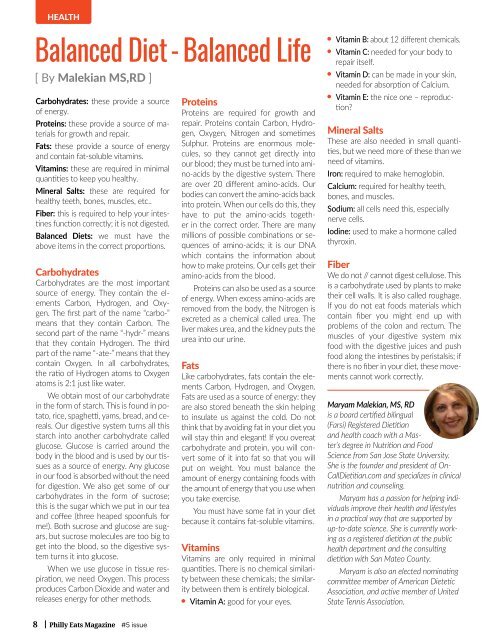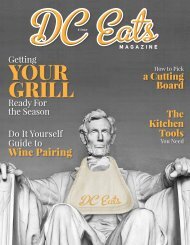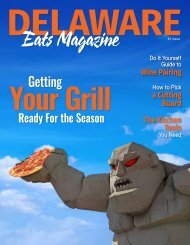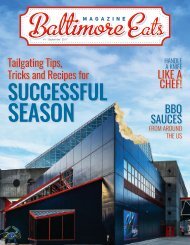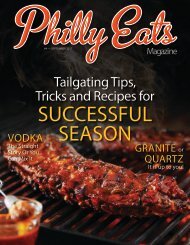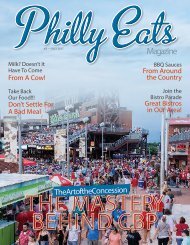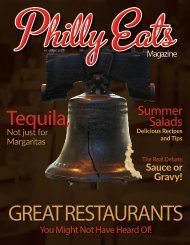Philly Eats Eats Magazine_#5
A foodie magazine that enjoys both cooking but dining out.
A foodie magazine that enjoys both cooking but dining out.
You also want an ePaper? Increase the reach of your titles
YUMPU automatically turns print PDFs into web optimized ePapers that Google loves.
health<br />
Balanced Diet - Balanced Life<br />
[ By Malekian MS,RD ]<br />
Carbohydrates: these provide a source<br />
of energy.<br />
Proteins: these provide a source of materials<br />
for growth and repair.<br />
Fats: these provide a source of energy<br />
and contain fat-soluble vitamins.<br />
Vitamins: these are required in minimal<br />
quantities to keep you healthy.<br />
Mineral Salts: these are required for<br />
healthy teeth, bones, muscles, etc..<br />
Fiber: this is required to help your intestines<br />
function correctly; it is not digested.<br />
Balanced Diets: we must have the<br />
above items in the correct proportions.<br />
Carbohydrates<br />
Carbohydrates are the most important<br />
source of energy. They contain the elements<br />
Carbon, Hydrogen, and Oxygen.<br />
The first part of the name “carbo-”<br />
means that they contain Carbon. The<br />
second part of the name “-hydr-” means<br />
that they contain Hydrogen. The third<br />
part of the name “-ate-” means that they<br />
contain Oxygen. In all carbohydrates,<br />
the ratio of Hydrogen atoms to Oxygen<br />
atoms is 2:1 just like water.<br />
We obtain most of our carbohydrate<br />
in the form of starch. This is found in potato,<br />
rice, spaghetti, yams, bread, and cereals.<br />
Our digestive system turns all this<br />
starch into another carbohydrate called<br />
glucose. Glucose is carried around the<br />
body in the blood and is used by our tissues<br />
as a source of energy. Any glucose<br />
in our food is absorbed without the need<br />
for digestion. We also get some of our<br />
carbohydrates in the form of sucrose;<br />
this is the sugar which we put in our tea<br />
and coffee (three heaped spoonfuls for<br />
me!). Both sucrose and glucose are sugars,<br />
but sucrose molecules are too big to<br />
get into the blood, so the digestive system<br />
turns it into glucose.<br />
When we use glucose in tissue respiration,<br />
we need Oxygen. This process<br />
produces Carbon Dioxide and water and<br />
releases energy for other methods.<br />
Proteins<br />
Proteins are required for growth and<br />
repair. Proteins contain Carbon, Hydrogen,<br />
Oxygen, Nitrogen and sometimes<br />
Sulphur. Proteins are enormous molecules,<br />
so they cannot get directly into<br />
our blood; they must be turned into amino-acids<br />
by the digestive system. There<br />
are over 20 different amino-acids. Our<br />
bodies can convert the amino-acids back<br />
into protein. When our cells do this, they<br />
have to put the amino-acids together<br />
in the correct order. There are many<br />
millions of possible combinations or sequences<br />
of amino-acids; it is our DNA<br />
which contains the information about<br />
how to make proteins. Our cells get their<br />
amino-acids from the blood.<br />
Proteins can also be used as a source<br />
of energy. When excess amino-acids are<br />
removed from the body, the Nitrogen is<br />
excreted as a chemical called urea. The<br />
liver makes urea, and the kidney puts the<br />
urea into our urine.<br />
Fats<br />
Like carbohydrates, fats contain the elements<br />
Carbon, Hydrogen, and Oxygen.<br />
Fats are used as a source of energy: they<br />
are also stored beneath the skin helping<br />
to insulate us against the cold. Do not<br />
think that by avoiding fat in your diet you<br />
will stay thin and elegant! If you overeat<br />
carbohydrate and protein, you will convert<br />
some of it into fat so that you will<br />
put on weight. You must balance the<br />
amount of energy containing foods with<br />
the amount of energy that you use when<br />
you take exercise.<br />
You must have some fat in your diet<br />
because it contains fat-soluble vitamins.<br />
Vitamins<br />
Vitamins are only required in minimal<br />
quantities. There is no chemical similarity<br />
between these chemicals; the similarity<br />
between them is entirely biological.<br />
Vitamin A: good for your eyes.<br />
Vitamin B: about 12 different chemicals.<br />
Vitamin C: needed for your body to<br />
repair itself.<br />
Vitamin D: can be made in your skin,<br />
needed for absorption of Calcium.<br />
Vitamin E: the nice one – reproduction?<br />
Mineral Salts<br />
These are also needed in small quantities,<br />
but we need more of these than we<br />
need of vitamins.<br />
Iron: required to make hemoglobin.<br />
Calcium: required for healthy teeth,<br />
bones, and muscles.<br />
Sodium: all cells need this, especially<br />
nerve cells.<br />
Iodine: used to make a hormone called<br />
thyroxin.<br />
Fiber<br />
We do not // cannot digest cellulose. This<br />
is a carbohydrate used by plants to make<br />
their cell walls. It is also called roughage.<br />
If you do not eat foods materials which<br />
contain fiber you might end up with<br />
problems of the colon and rectum. The<br />
muscles of your digestive system mix<br />
food with the digestive juices and push<br />
food along the intestines by peristalsis; if<br />
there is no fiber in your diet, these movements<br />
cannot work correctly.<br />
Maryam Malekian, MS, RD<br />
is a board certified bilingual<br />
(Farsi) Registered Dietitian<br />
and health coach with a Master’s<br />
degree in Nutrition and Food<br />
Science from San Jose State University.<br />
She is the founder and president of On-<br />
CallDietitian.com and specializes in clinical<br />
nutrition and counseling.<br />
Maryam has a passion for helping individuals<br />
improve their health and lifestyles<br />
in a practical way that are supported by<br />
up-to-date science. She is currently working<br />
as a registered dietitian at the public<br />
health department and the consulting<br />
dietitian with San Mateo County.<br />
Maryam is also an elected nominating<br />
committee member of American Dietetic<br />
Association, and active member of United<br />
State Tennis Association.<br />
8 <strong>Philly</strong> <strong>Eats</strong> <strong>Magazine</strong> <strong>#5</strong> issue<br />
<strong>#5</strong> issue <strong>Philly</strong> <strong>Eats</strong> <strong>Magazine</strong> 9


